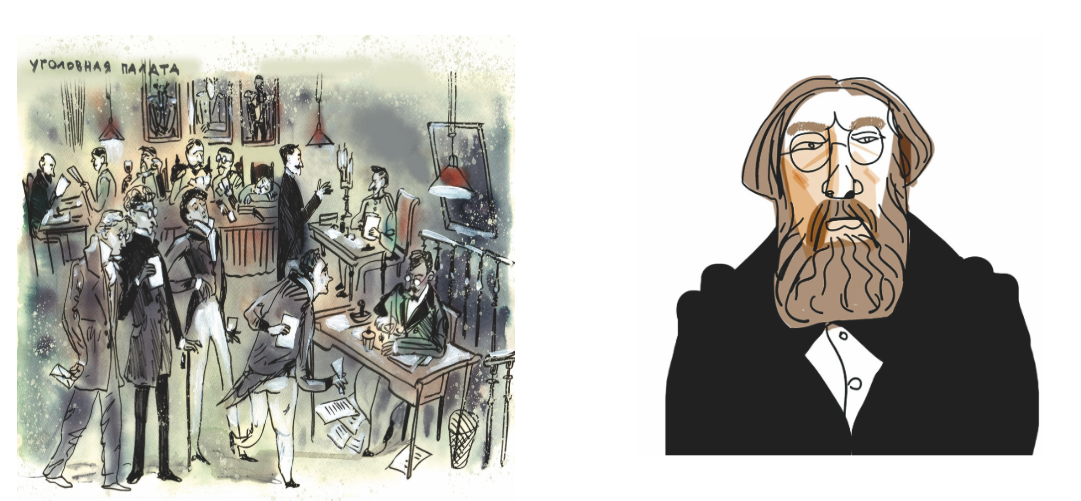"A Day at the Criminal Chamber. Scenes from the Court" (1858)

"A Day at the Criminal Chamber. Scenes from the Court" by Ivan Aksakov
Ivan Aksakov—a leader of the Slavophile movement, poet, and publicist—was the son of Sergei Aksakov, author of the famous fairy tale The Scarlet Flower (1858). Aksakov’s play "A Day at the Criminal Chamber. Scenes from the Court" serves as a documentary record of the pre-reform Russian judicial system, where the chairman of the criminal chamber, its secretary, and assessors institutionalized bribery, extortion, and graft.
The plot draws on Aksakov’s own biographical experience: for nearly two years, he served as assistant chairman of the Kaluga Criminal Chamber, gaining firsthand knowledge of the realities of the judicial system.
In letters to his family and to Ivan Turgenev, Aksakov documented his work on the play, modestly dismissing its literary pretensions. He argued that the text resembled an official report more than a work of art. Yet it is precisely this stylistic choice—the rejection of ornate metaphors and elegant epithets in favor of unvarnished realism—that lends the narrative exceptional authenticity.
Aksakov resents the fact how the judicial system remained stagnant for decades: typical court proceedings disproportionately favored noble interests, with the secretary deciding all cases while other officials merely rubber-stamped pre-prepared documents. Horrified, Aksakov observes that no objectivity could be expected in these sessions—testimony from noble witnesses was automatically deemed credible, and favors were routinely granted to acquaintances, especially when accompanied by a worthy reward on his part.
There are several main characters in the play - the president of the chamber, two assessors from the nobility, an assessor from the merchants, a secretary, three clerks, the chief watchman, escort soldiers and three prisoners.
The setting is the hearing room of a criminal chamber. Unlike Gogol’s caricatured bribe-takers, Aksakov’s characters are good-natured and even principled in their own way. The tragedy, as Aksakov sees it, lies in the fact that injustice and the officials’ vile actions are mostly unconscious, formal, and habitual. Indifference and exhaustion define the work of criminal chambers — whether in the capital or a provincial backwater.
Aleksey Alexandrovich Zhabin, the noble assessor, examines a theft case allegedly committed by a peasant belonging to his cousin. The woman asking for a pardon , as her scheme was to turn an unwelcome prisoner into a military service - thereby fulfilling her household's recruitment obligation to the state without suffering significant material losses. Zhabin insists on amending the case records to favor his cousin's interests.
In the Code of Laws of the Russian Empire, evidence was categorized as Perfect (complete) evidence - a personal confession, and Imperfect evidence - testimony of a single witness, with the testimony of two appropriate witnesses being a perfect proof.
Perfect evidence served as the basis for a conviction; otherwise, testimony from multiple witnesses was required. The presence of just one piece of imperfect evidence did not permit an acquittal. The common practice of evaluating a case's evidentiary basis solely through brief summaries prepared by court secretaries created favorable conditions for systemic corruption. The revised Judicial Statutes of 1864, implemented following Alexander II's judicial reforms, introduced key principles:
Free evaluation of evidence by courts
Oral proceedings
Public hearings
Direct examination of evidence
These measures legally guaranteed judicial objectivity and impartiality.
Aksakov delivers a scathing critique of the pre-reform judicial system: "A web of vices and moral failings entangles society, making everyone—to some degree—both victim and willing accomplice." He calls for structural government reforms, arguing they would only prove effective alongside strengthened social and civic responsibility.
Symbols and Signs in the Illustration
The details of criminal proceedings in pre-reform 19th-century Russia